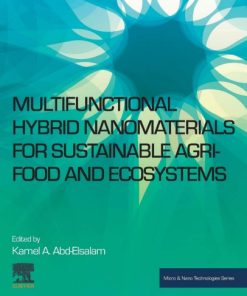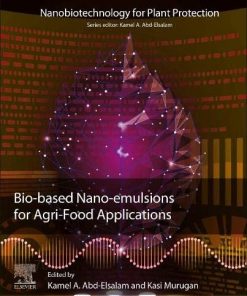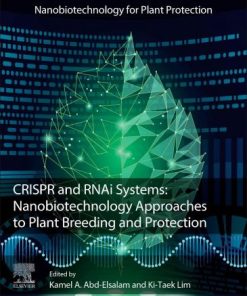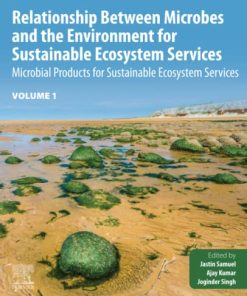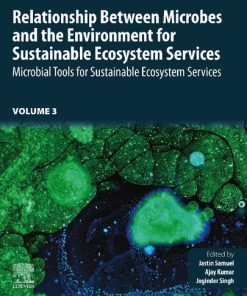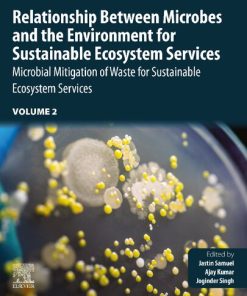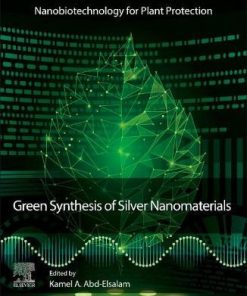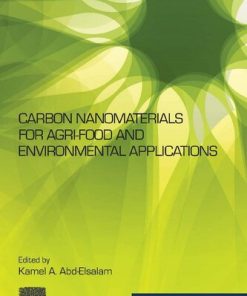Agri Waste and Microbes for Production of Sustainable Nanomaterials 1st edition by Kamel Abd Elsalam 9780128235768
$50.00 Original price was: $50.00.$25.00Current price is: $25.00.
Agri-Waste and Microbes for Production of Sustainable Nanomaterials 1st edition by Kamel A. Abd-Elsalam – Ebook PDF Instant Download/DeliveryISBN: 9780128235768
Full download Agri-Waste and Microbes for Production of Sustainable Nanomaterials 1st edition after payment.
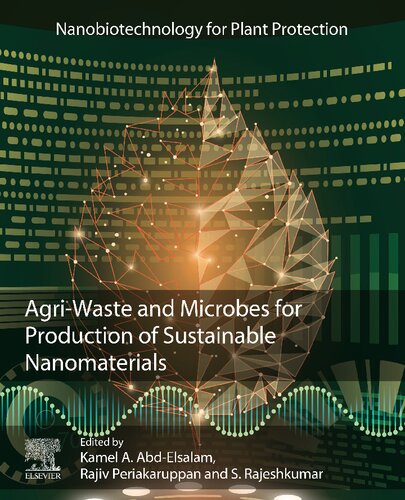
Product details:
ISBN-13 : 9780128235768
Author : Kamel A. Abd-Elsalam
Agri-Waste and Microbes for Production of Sustainable Nanomaterials assesses the most recent trends used to produce bionanomaterials from agricultural waste and microorganisms. The book covers the green synthesis of various nanomaterials using microorganisms and agricultural waste, including the synthesis and characterization of green nanomaterials, the production of nanomaterials from agri-waste, including metallic, copper, silica, cellulose, nanopolymers and nano/micro plastics, and biological methods such as agricultural and microbial synthesis of metallic/metal oxide, magnetic, silver, copper, nanomaterials and nanonutrients. This is an important reference source for plant scientists, materials scientists and environmental scientists who want to understand this new generation of sustainable nanomaterials.
Agri-Waste and Microbes for Production of Sustainable Nanomaterials 1st Table of contents:
Chapter 1: Sustainable strategies for producing large-scale nanomaterials: A note from the editors
Abstract
1: Introduction
2: Green synthesis nanomaterials
3: Enzymes mediated nano synthesis
4: Protein-mediated nano synthesis
5: Polysaccharide mediated nano synthesis
6: Large-scale production of nanoparticles
7: Advantages
8: Future perspectives
9: Conclusion
References
Part I: Agri-waste for production of nanomaterials
Chapter 2: Synthesis of metal nanoparticles by microbes and biocompatible green reagents
Abstract
1: Introduction
2: Synthesis by microorganisms
3: Synthesis by biocompatible green reagents
4: Factors affecting biogenic synthesis of MNPs
5: Conclusion and future perspectives
References
Chapter 3: Plant and agri-waste-mediated synthesis of metal nanoparticles
Abstract
1: Introduction
2: Synthesis from plant materials
3: Synthesis from agri-waste
4: Factors influencing the biosynthesis of nanoparticles
5: Conclusion and future prospective
References
Chapter 4: Plant-mediated copper nanoparticles for agri-ecosystem applications
Abstract
1: Introduction
2: Synthesis of copper nanoparticles
3: Implementation of Cu-NPs in agriculture
4: Phytotoxicity and interaction with soil community
5: Application of copper nanoparticles
6: Conclusion and prospects
References
Chapter 5: Synthesis of silica nanoparticles from agricultural waste
Abstract
1: Introduction
2: Agricultural waste
3: Effects of agricultural wastes
4: Silica nanoparticles
5: Conclusion
References
Further reading
Chapter 6: Biomolecule-assisted biogenic synthesis of metallic nanoparticles
Abstract
1: Introduction
2: Categories of biomolecules used in biosynthesis of nanoparticles
3: Conclusion and future prospects
References
Chapter 7: Bacterial and fungal mediated synthesis, characterization and applications of AgNPs
Abstract
1: Introduction
2: Green synthesis of AgNPs
3: Conclusion
References
Chapter 8: Agro-waste materials: Sustainable substrates in nanotechnology
Abstract
Acknowledgments
1: Introduction
2: Horticultural wastes
3: Synthesis of various nanoparticles using agricultural wastes
4: Carbon dots, a major nanomaterial from agricultural wastes
5: Nanocomposites from wastes and their applications
6: Shortcomings and future perspective
References
Chapter 9: Synthesis of eco-friendly graphene from agricultural wastes
Abstract
1: Introduction
2: Modified Hummer’s method
3: Graphene synthesis from agricultural wastes
4: Conclusions
References
Chapter 10: Fruit peel waste-to-wealth: Bionanomaterials production and their applications in agroecosystems
Abstract
1: Introduction
2: Fruit peel physicochemical and biochemical characters
3: Synthesis of metallic nanoparticles from fruit peel
4: Bioactive compounds in fruit peels hybrid with nanomaterials
5: Synthesis mechanisms
6: Further prospective and challenges
7: Conclusion
References
Chapter 11: Eggshell and fish/shrimp wastes for synthesis of bio-nanoparticles
Abstract
Acknowledgments
1: Introduction
2: Chemical composition of eggshells and fish/shrimp waste
3: Synthesis of nanoparticles from eggshells and fish/shrimp waste
4: Properties of fish/shrimp waste and eggshell derived nanoparticles
5: Applications
6: Application of modeling and optimization techniques for nanoparticles
7: Conclusions
References
Chapter 12: Vegetables waste for biosynthesis of various nanoparticles
Abstract
Acknowledgment
1: Introduction
2: Green synthesis process for nanomaterials
3: Vegetable wastes as nanofactories
4: Synthesis of carbon-based nanomaterials from vegetable waste
5: Biosynthesis of NPs from vegetable wastes
6: Mechanism of nanoparticle formation
7: Morphology control of plant extract nanoparticles
8: Conclusion
References
Part II: Microorganisms for nanomaterials synthesis
Chapter 13: Microbes and agricultural waste: A safe resource for the production of bionanomaterials
Abstract
1: Introduction
2: Microbial nanostructures
3: Agro-based nanostructures
4: Mechanisms of nanostructures
5: Conclusion
References
Chapter 14: Microbial synthesis of magnetic nanomaterials
Abstract
1: Introduction
2: General synthesis of nanoparticles
3: Chemical synthesis of magnetic nanoparticles
4: Magnetic nanoparticles: Synthesis and applications
5: Conclusion and further outlook
References
Chapter 15: Mycogenic nanoparticles: Synthesis, characterizations and applications
Abstract
1: Introduction
2: Myconanotechnoloy: Fungi as a potential source for mycogenic nanoparticles
3: Intracellular and extracellular synthesis of mycogenic nanoparticle with types
4: Mechanism of mycogenic nanoparticle biosynthesis
5: Characterization of mycogenic nanoparticles
6: Applications of mycogenic nanoparticles
7: Conclusions
References
Chapter 16: Actinomycetes-assisted nanoparticles: Synthesis and applications
Abstract
1: Introduction
2: Isolation of actinomycetes
3: Actinomycete assisted synthesis of nanoparticles
4: Applications of actinomycete synthesized nanoparticles
5: Toxicity of nanoparticles
6: Conclusion
References
Chapter 17: Biosynthesis of Silver Nanoparticles: Synthesis, mechanism, and characterization
Abstract
1: Introduction
2: Methods of preparation of silver nanoparticle
3: Mechanism of biosynthesis of silver nanoparticles
4: Characterization techniques of silver nanoparticles
5: Conclusion
References
Chapter 18: Agri-food and environmental applications of bionanomaterials produced from agri-waste and microbes
Abstract
1: Introduction
2: Agri-food applications
3: Environmental applications
4: Conclusion
References
Chapter 19: Benign fabrication of metallic/metal oxide nanoparticles from algae
Abstract
Acknowledgments
1: Introduction
2: Preference for plants
3: Algae
4: Nanoparticles from microalgae
5: Nanoparticles synthesized by macroalgae
6: Possible mechanism
7: Diatoms
8: Future outlook
9: Conclusion
References
Chapter 20: Biogenic metal sulfide nanoparticles synthesis and applications for biomedical and environmental technology
Abstract
1: Introduction
2: Metal nanoparticles
3: Metal sulfide nanoparticles
4: Conclusion
References
Chapter 21: Microbial-mediated copper nanoparticles synthesis, characterization, and applications
Abstract
1: Introduction
2: Copper nanoparticles
3: Techniques for the synthesis of copper nanoparticles
4: Need for microbial-mediated synthesis of copper nanoparticles
5: Microbial-mediated synthesis of copper nanoparticles
6: Characterization of copper nanoparticles
7: Applications of CuNPs
8: Conclusion
References
Chapter 22: Green nanomaterials produced by agro-waste and microbes: Mechanisms and risk assessment
Abstract
1: Introduction
2: Green nanomaterials from agriculture waste
3: Green nanomaterials from microbial biomass
4: Conclusion
References
Chapter 23: Frontier and perspective outlook on agrowaste nanoparticles for healthcare and environment
Abstract
1: Introduction
2: Nanoparticle synthesis using agricultural waste
3: Applications
4: Limitations of nanotechnology in healthcare
5: Conclusion
References
Chapter 24: Mechanistic approach on the synthesis of metallic nanoparticles from microbes
Abstract
1: Introduction
2: Synthesis of nanoparticles
3: Conclusion
References
Chapter 25: Microbially synthesized nanoparticles: A promising future for insecticidal efficacy studies
Abstract
1: Introduction
2: Types of nanoparticles
3: Synthesis of nanoparticles
4: Microbial synthesis of nanoparticles
5: Mechanism of nanoparticle formation
6: Insecticidal efficacy of microbial-mediated nanoparticles
7: Future perspectives
8: Conclusion
References
Chapter 26: Biomedical applications of ginsenosides nanoparticles synthesized using microbes
Abstract
1: Introduction
2: Probiotics
3: Mechanisms of the microbial synthesis of nanoparticles
4: Biomedical applications of nanoparticles
5: Bacteria based nanoparticles
6: Ginseng
7: Microbial synthesis of the ginsenoside nanoparticles and applications
8: Futuristic views
9: Conclusion
References
Chapter 27: Synthesis of selenium nanoparticles by using microorganisms and agri-based products
Abstract
1: Introduction
2: Synthesis of SeNPs
3: Characterizations of SeNPs
4: Applications of SeNPs
5: Conclusions
References
Further reading
Chapter 28: Plant-meditated methods for synthesis of silver nanoparticles
Abstract
1: Introduction
2: Types of green approaches for Ag-nanomaterials
3: Green synthesis
4: Applications of silver nanoparticles
5: Conclusions
References
Chapter 29: Rice wastes for green production and sustainable nanomaterials: An overview
Abstract
1: Introduction
2: Types of rice wastes
3: Amount of rice wastes
4: Utilization of rice-waste
5: Agric-waste as green sources of nanoparticles
6: Nanomaterials extracted from rice wastes
7: Applications of rice bio nanomaterials
8: Conclusion future perspectives
People also search for Agri-Waste and Microbes for Production of Sustainable Nanomaterials 1st:
list of microbes used in agriculture
how microbes are useful in agriculture
agri-waste technology
agri-waste
agri-waste technology inc
Tags:
Agri Waste,Microbes,Production,Sustainable Nanomaterials,Kamel Abd Elsalam
You may also like…
Engineering - Electrical & Electronic Engineering
Engineering
Multifunctional Hybrid Nanomaterials for Sustainable Agri-food and Ecosystems 1st Edition
Technique - Nanotechnology
Bio-Based Nanoemulsions for Agri-Food Applications 1st Edition Kamel A. Abd-Elsalam
Biology and other natural sciences - Biotechnology
Biology and other natural sciences - Microbiology
Biology and other natural sciences - Ecology
Science (General) - Science of Science




